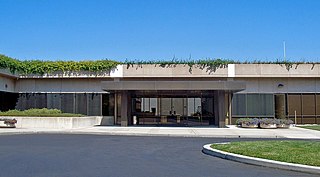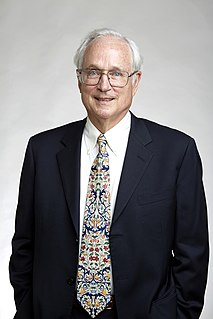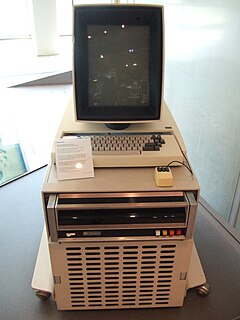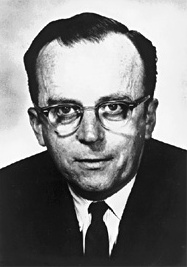Related Research Articles

PARC is a research and development company in Palo Alto, California. Formed in 1969, the company was originally a division of Xerox, and was tasked with creating computer technology-related products and hardware systems.

Butler W. Lampson, ForMemRS, is an American computer scientist best known for his contributions to the development and implementation of distributed personal computing.

The Xerox Alto is the first computer designed from its inception to support an operating system based on a graphical user interface (GUI), later using the desktop metaphor. The first machines were introduced on 1 March 1973, a decade before mass-market GUI machines became available.

Joseph Carl Robnett Licklider, known simply as J. C. R. or "Lick", was an American psychologist and computer scientist who is considered among prominent figures in computer science development and general computing history.

William Robert Sutherland was an American computer scientist who was the longtime manager of three prominent research laboratories, including Sun Microsystems Laboratories (1992–1998), the Systems Science Laboratory at Xerox PARC (1975–1981), and the Computer Science Division of Bolt, Beranek and Newman, Inc. which helped develop the ARPANET.

Robert William Taylor, known as Bob Taylor, was an American Internet pioneer, who led teams that made major contributions to the personal computer, and other related technologies. He was director of ARPA's Information Processing Techniques Office from 1965 through 1969, founder and later manager of Xerox PARC's Computer Science Laboratory from 1970 through 1983, and founder and manager of Digital Equipment Corporation's Systems Research Center until 1996.
George E. Pake was a physicist and research executive primarily known for helping found Xerox PARC.

Maze, later expanded and renamed to Maze War, is a 3D networked first-person shooter originally developed by Steve Colley, Greg Thompson, and Howard Palmer for the Imlac PDS-1 computer. It was largely developed between the summer of 1972 and fall of 1973, at which point it included shooter elements and soon after was playable over ARPANET between multiple universities. It is considered the earliest first-person shooter; ambiguity over its development timeline has led it to be considered, along with Spasim, to be one of the "joint ancestors" of the genre.
SRI International's Augmentation Research Center (ARC) was founded in the 1960s by electrical engineer Douglas Engelbart to develop and experiment with new tools and techniques for collaboration and information processing.

Charles Patrick "Chuck" Thacker was an American pioneer computer designer. He designed the Xerox Alto, which is the first computer that used a mouse-driven graphical user interface (GUI).
Joel Moses is an Israeli-American mathematician, computer scientist and Institute Professor Emeritus at the Massachusetts Institute of Technology (MIT).

Paul Dourish is a computer scientist best known for his work and research at the intersection of computer science and social science. Born in Scotland, he is a professor of Informatics at the University of California, Irvine, where he joined the faculty in 2000, and where he directs the Steckler Center for Responsible, Ethical, and Accessible Technology. He is a Fellow of the ACM and the British Computer Society, and winner of the CSCW 2016 "Lasting Impact" award. Dourish has published three books and over 100 scientific articles, and holds 19 US patents.

The MIT School of Engineering (SoE) is one of the five schools of the Massachusetts Institute of Technology, located in Cambridge, Massachusetts, United States. SoE has eight academic departments and two interdisciplinary institutes. The School grants SB, MEng, SM, engineer's degrees, and PhD or ScD degrees. As of 2019, the Dean of Engineering is Professor Ian Waitz. The school is the largest at MIT as measured by undergraduate and graduate enrollments and faculty members.
The Stanford University Network, also known as SUN, SUNet or SU-Net is the campus computer network for Stanford University.

The Brown University School of Engineering is the engineering school at Brown University, a private Ivy League research university located in Providence, Rhode Island. The school offers both graduate and undergraduate study in the field. Although undergraduate students may officially declare their major in engineering as late as the end of their sophomore year, students with an intention in majoring in engineering typically must begin the engineering curriculum their first semester at Brown.
The Symposium on Principles of Self-Organization was held at Allerton House on 8–9 June 1960. It was a key conference in the development of cybernetics and was in many ways a continuation of the Macy Conferences. it was organised by Heinz von Foerster through the Biological Computer Laboratory based at University of Illinois at Urbana-Champaign. It was sponsored by the Information Systems Branch of the U.S. Office of Naval Research.
Lawrence Valenstein (1899–1982) was an American advertising executive who founded the Grey Advertising Agency.
Daniel P. Huttenlocher is an American computer scientist, academic administrator and corporate director. He is the inaugural dean of the Schwarzman College of Computing at the Massachusetts Institute of Technology. Previously, he was the inaugural dean and vice provost of Cornell Tech at Cornell University, and a director of Amazon. He joined the department of computer science at Cornell in 1988, and he owned 24 patents in computer vision by 2015.
References
- 1 2 "Jerome I. Elkind '51, ScD '56". MIT Energy Initiative. MIT. Retrieved 20 December 2016.
- 1 2 3 Hiltzik, Michael (2000). Dealers of Lightning: Xerox Parc and the Dawn of the Computer Age . Harper Business.
- ↑ Hutchinson, Jamie. ""Nerve center" of the cybernetic world Heinz von Foerster and the Biological Computer Laboratory". Biological Computer Laboratory. University of Illinois. Retrieved 24 October 2016.
- 1 2 "Jerome Elkind: Executive Profile & Biography - Bloomberg". www.bloomberg.com. Bloomberg. Retrieved 20 December 2016.
- ↑ Herald Statesman: "Dr. Elkind, Engineer Weds Scarsdale Girl" January 19, 1959